
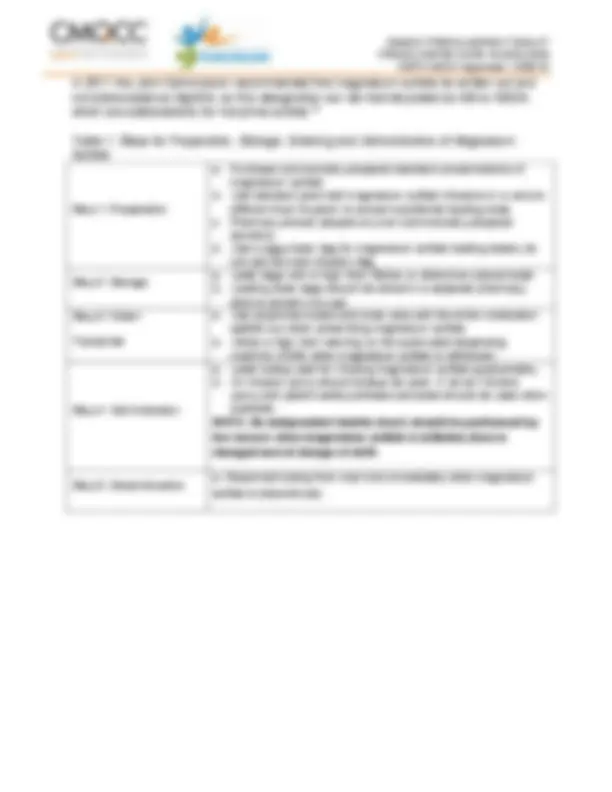
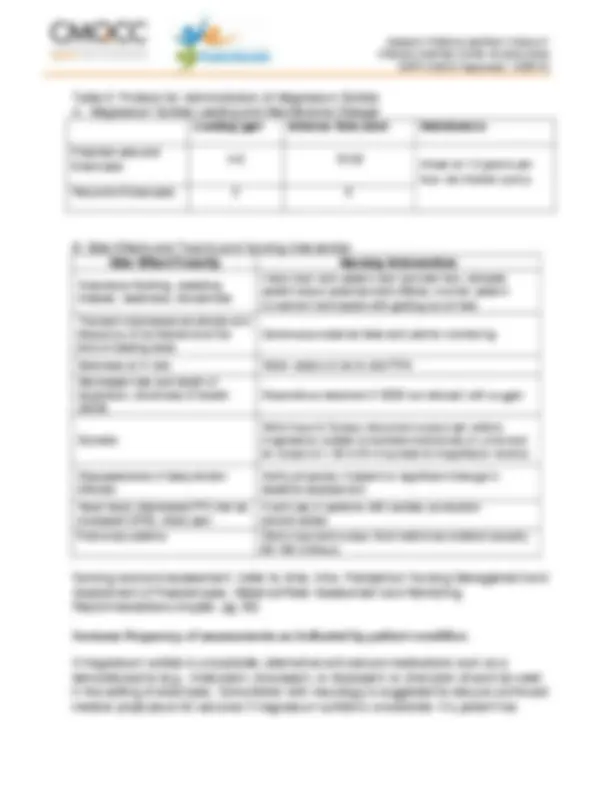
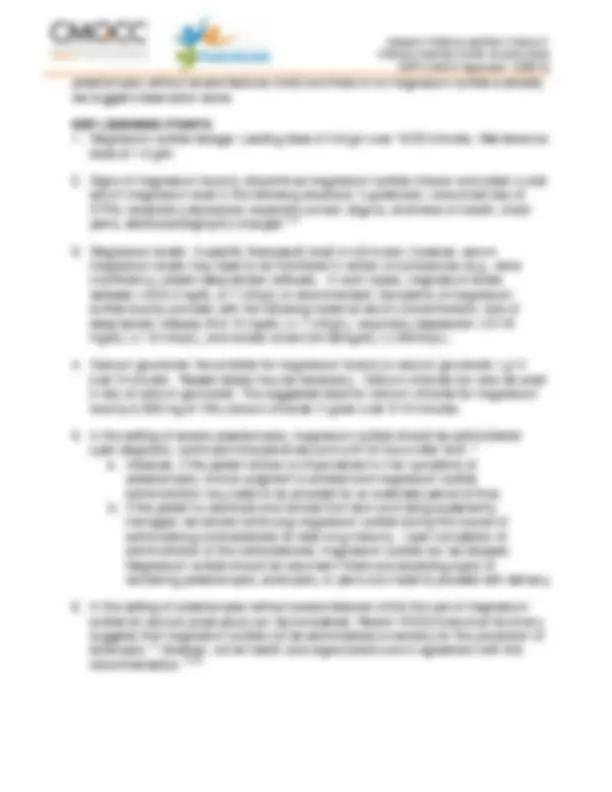
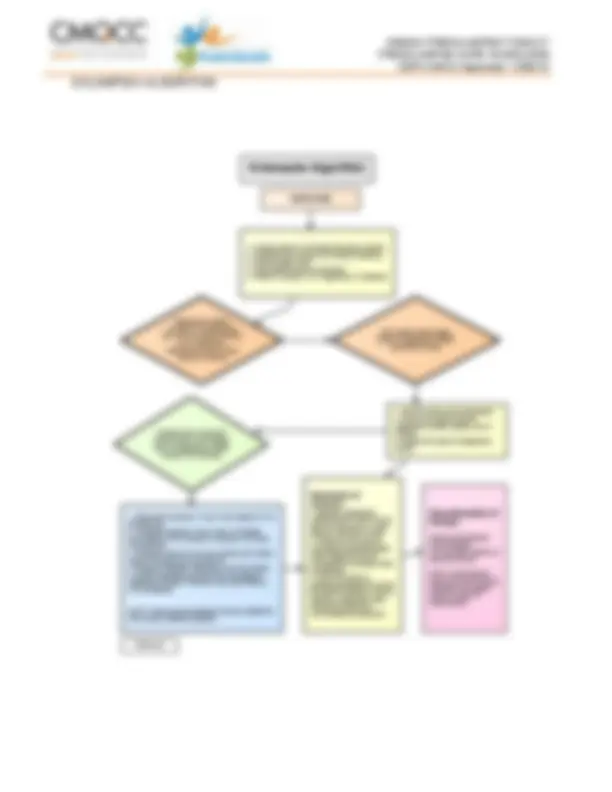
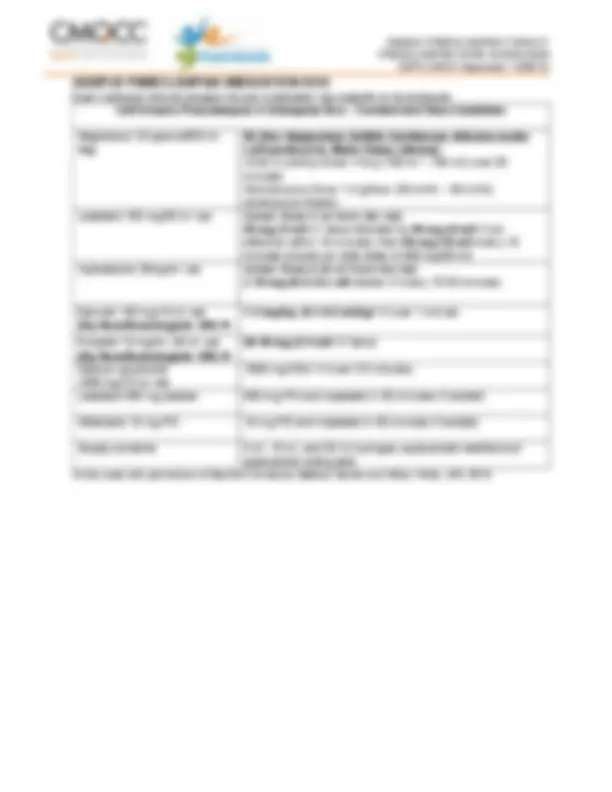


Study with the several resources on Docsity

Earn points by helping other students or get them with a premium plan


Prepare for your exams
Study with the several resources on Docsity

Earn points to download
Earn points by helping other students or get them with a premium plan
Community
Ask the community for help and clear up your study doubts
Discover the best universities in your country according to Docsity users
Free resources
Download our free guides on studying techniques, anxiety management strategies, and thesis advice from Docsity tutors
The use of magnesium sulfate in the treatment of severe preeclampsia and eclampsia, as well as the controversy surrounding its use in mild preeclampsia. It also covers guidelines for the preparation, storage, and administration of magnesium sulfate, as well as its side effects and toxicity. The document also mentions alternative anti-seizure medications and the role of calcium gluconate as an antidote for magnesium toxicity.
What you will learn
Typology: Schemes and Mind Maps
1 / 9

This page cannot be seen from the preview
Don't miss anything!






PREECLAMPSIA CARE GUIDELINES CDPH-MCAH Approved: 12/20/ MAGNESIUM SULFATE Ocean Berg, RN, MSN, IBCLC, Nurse Family Partnership Program Richard H. Lee, MD, University of Southern California Brenda Chagolla, RN, MSN, CNS, University of California, Davis Medical Center BACKGROUND Magnesium sulfate is the primary medication used in the prevention and management of eclamptic seizures and exerts its effect by depressing the central nervous system. 1 In the setting of severe preeclampsia, magnesium sulfate has been shown to significantly reduce the rate of eclampsia compared to placebo, phenytoin, nimodipine, or diazepam. In the setting of eclampsia, magnesium sulfate has been demonstrated to be superior to diazepam, phenytoin, or lytic cocktails in reducing the risk of recurrent seizures as well as reducing the risk of maternal death. 2 - 7 However, controversy surrounds the use of magnesium in the setting of preeclampsia without severe features (mild) with some studies finding no difference and others alluding to a potential benefit. 8, The Magpie Trial demonstrated the numbers of women who needed to be treated in order to prevent one seizure was 63 in subjects with severe preeclampsia and 109 in those with preeclampsia without severe features (mild). 2 A similar rate of eclampsia (1.1%) was observed when magnesium sulfate was not used in women with less severe disease.^10 The current ACOG Hypertension in Pregnancy publication has the following statement regarding magnesium sulfate therapy for preeclampsia without severe features: 11 “For women with preeclampsia with systolic BP of less than 160 mm HG and a diastolic BP less than 110 mm HG and no maternal symptoms, it is suggested that magnesium sulfate not be administered universally for the prevention of eclampsia.” (Quality of Evidence: Low; Strength of recommendation: Qualified) “When the task force has made a ‘qualified’ recommendation the health care provider and patient are encouraged to work together to arrive at a decision based on the values and judgment and underling health condition of a particular patient in a particular situation.” Currently, the use of magnesium sulfate in severe preeclampsia and eclampsia is supported by The American Congress of Obstetricians and Gynecologists (ACOG), 12 World Health Organization (WHO),^13 Society of Obstetricians and Gynaecologists of Canada (SOGC), 14 and the National Institute for Health and Clinical Excellence (NICE). 15 Of these, the SOGC and WHO provide statements that support the use of magnesium sulfate in the setting of preeclampsia without severe features (mild).13,
PREECLAMPSIA CARE GUIDELINES CDPH-MCAH Approved: 12/20/ Magnesium sulfate is listed by the Institute of Safe Medication Practices (ISMP) as a high-alert medication. 16 In 2004, published data about Medication Errors in Labor, Delivery, Recovery, and Postpartum (LDRP’s), magnesium sulfate was identified as the second most common product to be mismanaged in the Labor, Delivery and Recovery (LDR) area. 16 The Association of Women’s Health Obstetric and Neonatal Nurses (AWHONN) updated their nurse staffing guidelines in 2010.^17 Specific guidelines are identified for magnesium sulfate throughout the inpatient stay as follows:
PREECLAMPSIA CARE GUIDELINES CDPH-MCAH Approved: 12/20/ Table 2: Protocol for Administration of Magnesium Sulfate A. Magnesium Sulfate Loading and Maintenance Dosage Loading (gm) Infusion Rate (min) Maintenance Preeclampsia and Eclampsia 4 - 6 15 - (^20) Infuse at 1-2 grams per hour via infusion pump Recurrent Eclampsia 2 5 B. Side Effects and Toxicity and Nursing Intervention Side Effect/Toxicity Nursing Intervention Cutaneous flushing, sweating, malaise, weakness, drowsiness Keep room and patient cool (provide fan), educate patient about potential side effects; monitor patient movement and assist with getting out of bed Transient decreased amplitude and frequency of contractions at the time of loading dose Continuous external fetal and uterine monitoring Soreness at IV site Warm soaks or ice to site PRN Decreased rate and depth of respiration, shortness of breath (SOB) Discontinue treatment if SOB not relieved with oxygen Diuresis Strict Input & Output; document output per orders; magnesium sulfate is excreted exclusively in urine and an output of < 30 ml/hr may lead to magnesium toxicity Disappearance of deep tendon reflexes Notify physician if absent or significant change in baseline assessment Heart block (decreased PR interval, increased QRS), chest pain Avoid use in patients with cardiac conduction abnormalities Pulmonary edema Strict input and output, fluid restrict as ordered (usually 60 - 100 ml/hour) Nursing care and assessment: (refer to Ante, Intra, Postpartum Nursing Management and Assessment of Preeclampsia: Maternal/Fetal Assessment and Monitoring Recommendations chapter, pg. 35) Increase frequency of assessments as indicated by patient condition. If magnesium sulfate is unavailable, alternative anti-seizure medications such as a benzodiazepine (e.g., midazolam, lorazepam, or diazepam) or phenytoin should be used in the setting of eclampsia. Consultation with neurology is suggested to discuss continued medical prophylaxis for seizures if magnesium sulfate is unavailable. If a patient has
PREECLAMPSIA CARE GUIDELINES CDPH-MCAH Approved: 12/20/ preeclampsia without severe features (mild) and there is no magnesium sulfate available, we suggest observation alone. KEY LEARNING POINTS
PREECLAMPSIA CARE GUIDELINES CDPH-MCAH Approved: 12/20/
5. Duley L, Henderson-Smart D. Magnesium sulphate versus phenytoin for eclampsia. In: 2003;4(4):CD000128 CDSR, ed2003. 6. Duley L, Matar H, Almerie MQ, Hall D. Alternative magnesium sulphate regimens for women with preeclampsia and eclampsia. In: 2010;4(8):CD007388 CDSR, ed2010. 7. Duley L, Matar HE, Almerie MQ, Hall DR. Alternative magnesium sulphate regimens for women with pre-eclampsia and eclampsia. Cochrane Database of Systematic Reviews. 2010(8):CD007388. 8. Ehrenberg H, Mercer B. Abbreviated postpartum magnesium sulfate therapy for women with mild preeclampsia: a randomized controlled trial. Obstet Gynecol. 2006;108(4):833-838. 9. Livingston J, Livingston L, Ramsey R, Mabie B, Sibai B. Magnesium sulfate in women with mild preeclampsia: a randomized controlled trial. Obstet Gynecol. 2003;101(2):217-220. 10. Alexander J, McIntire D, Leveno K, Cunningham F. Selective magnesium sulfate prophylaxis for the prevention of eclampsia in women with gestational hypertension. Obstet Gynecol. 2006;108(4):826-832. 11. ACOG. Hypertension in Pregnancy: Report of the American College of Obstetricians and Gynecologists' Task Force on Hypertension in Pregnancy. Obstet Gynecol. 2013;122(5):1122-1131. 12. ACOG. Diagnosis and Management of Preeclampsia and Eclampsia #33. American Congress of Obstetricians and Gynecologists Practice Bulletin Number 33. 2002 (Reaffirmed 2012). 13. World Health Organization. WHO Recommendations for Prevention and Treatment of Preeclampsia and Eclampsia: Evidence Base. 2011. 14. Magee LA, Abalos E, von Dadelszen P, Sibai B, Easterling T, Walkinshaw S. How to manage hypertension in pregnancy effectively. Br J Clin Pharmacol. Sep 2011;72(3):394-401. 15. Visintin C, Mugglestone M, Almerie MQ, Nherera L, James DC, Walkinshaw S. Management of hypertensive disorders during pregnancy: summary of NICE guidance. BMJ. 2010;25(341(25)):c2207. 16. Institute for Safe Medication Practices. Failure to set a volume limit for a magnesium bolus dose leads to harm. 2010; http://www.ismp.org/newsletters/acutecare/articles/20100603.asp. 17. Beyea S, Kobokovich L, Becker S, Hicks R. Medication Errors in the LDRP: Identifying Common Errors Through MEDMARX Reporting. AWHONN: Lifelines. 2004;8(2):130-140. 18. The Joint Commission. Facts about the Official “Do Not Use” List. 2011. 19. Simpson K, Crehan P. Perinatal Nursing 4th ed. Philadelphia: Wolters/Kluwer/Lippincott Williams & Wilkins; 2014 pg. 136. 20. World Health Organization. Recommendations for the prevention and treatment of pre-eclampsia and eclampsia. 2011.
PREECLAMPSIA CARE GUIDELINES CDPH-MCAH Approved: 12/20/ ECLAMPSIA ALGORITHM